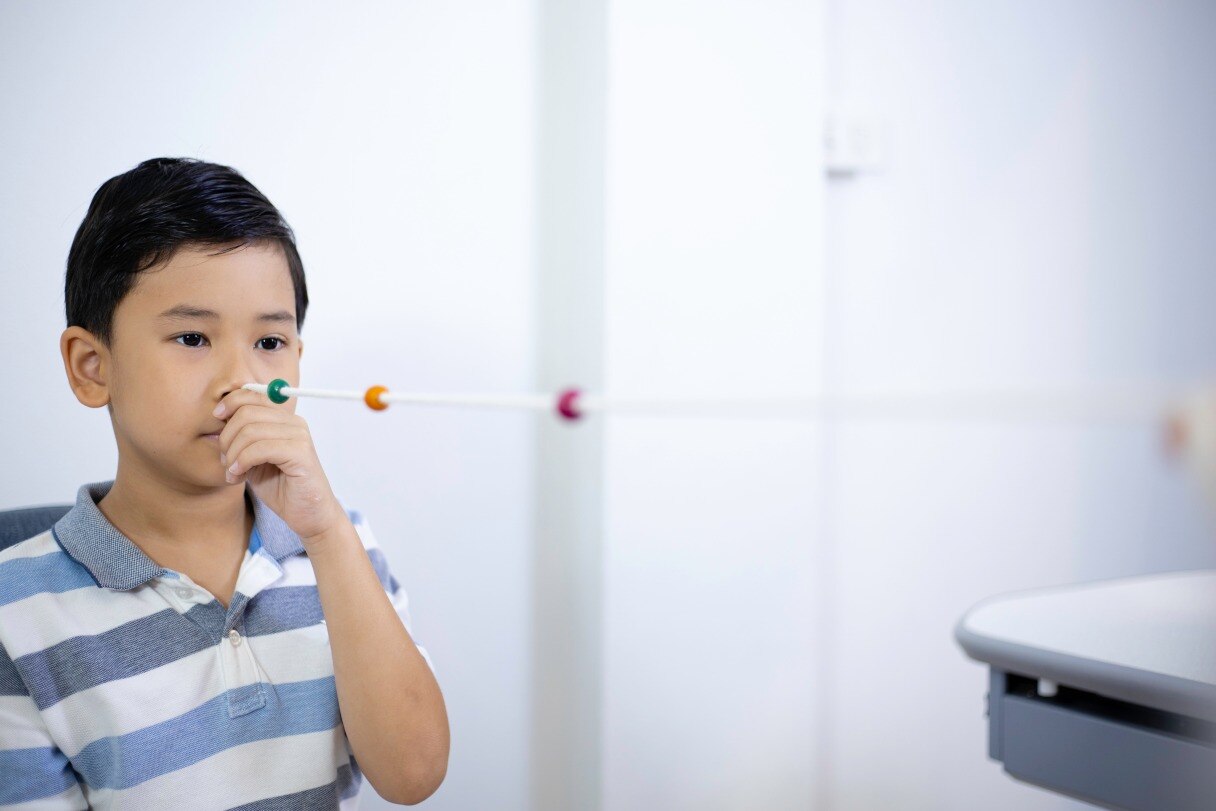Vision therapy uses specialized eye exercises to retrain your eyes and brain, improving the quality of your eyesight and visual processing.1 If you or your child struggles with issues like headaches, eye strain, reading comfortably, focusing or even tracking moving objects, you might benefit from this therapy. Even people with 20/20 vision may still need vision therapy.2
Vision therapy is a non-invasive treatment that can improve certain eye conditions.2 Children struggling with reading may be referred for vision therapy to address potential visual processing issues that could affect their ability to recognize words, track lines of text or maintain focus while reading.3 However, the efficacy of this therapy for childhood learning disabilities is still debated among professionals.3 That's why it's important to understand all the ins and outs of vision therapy and the options available to you.
Understanding Vision Therapy
Vision therapy is personalized for each individual and involves in-office visits coupled with at-home exercises.1 It may help people with symptoms such as:4
- Blurry vision
- Dizziness and balance problems
- Eye strain
- Fatigue
- Headaches
- Losing your place while reading
- Making errors on everyday tasks
- Needing to work harder than others to complete tasks
Eye problems that vision therapy can treat
Examples of visual disorders treated by vision therapy include:4
- Amblyopia (lazy eye)
- Binocular or eye teaming issues such as convergence insufficiency (when your eyes don't work well together when focusing on close objects)2
- Double vision
- Dyslexia
- Eye focusing problems
- Eye movement disorders such as problems tracking words, moving objects or shifting your eyes quickly2
- Hand-eye coordination
- Strabismus (crossed eyes)2
- Visual disorders from brain injuries1
- Visual perceptual issues, such as trouble identifying what you see and associating it with images stored in your brain
How Vision Therapy Works
With vision therapy, you'll be given individualized exercises that can strengthen neural connections associated with vision.4 Tools your doctor might use include electronic targets with timing mechanisms, balance boards, patches, prisms or therapeutic lenses.5
You'll typically see an optometrist once or twice a week for sessions that last 30 minutes to an hour.5 How many sessions you'll need depends on your visual disorder, how severe it is and how you perform on tests that check your progress.4
Here's a closer look at how it works:
Assessment and diagnosis
Your optometrist will give you a thorough eye exam along with a series of visual tests to determine what condition you have and which therapy will help.1
Personalized treatment plans
Most personalized treatment plans involve in-office therapy sessions, coupled with at-home exercises to reinforce them.1 The goal isn't to strengthen your eye muscles — rather, it's to help retrain how your vision functions on a neural level.5
For example, people with hand-eye coordination issues might be given drawing, tracing or catching tasks. People with eye movement issues might practice tracking moving objects or patterns, improving their speed and accuracy over time.6
The role of technology in vision therapy
Digital exercise and computer-assisted technologies play an important role in vision therapy. Today, some offices use virtual reality for practicing visual tasks in more realistic settings, or they might use interactive computer programs and apps to increase engagement and motivation.6
Benefits of Vision Therapy
Vision therapy brings a number of benefits depending on your issue, such as:4
- Better balance
- Better concentration
- Improved hand-eye coordination that can help with sports
- Less eye strain and headaches
- Improving how you process and interpret visual information5
Common Misconceptions About Vision Therapy
When it comes to vision therapy, it's important to separate myths from facts. Not all professionals agree this therapy works. However, developmental and behavioral optometrists have been using it for decades and believe in its effectiveness. They point to some studies showing that office-based vision therapy can help patients with convergence insufficiency.3
However, organizations like the American Association for Pediatric Ophthalmology and Strabismus believe there's simply not enough data to show vision therapy works for childhood learning disabilities. A 2022 study, for example, found that vision therapy may help with convergence problems but lacks sufficient evidence for treating learning disabilities. That study recommends that parents using vision therapy for their children should only do so alongside treatment by a pediatric ophthalmologist.7
Boston Children's Hospital reports seeing numerous children benefit from vision therapy for issues like accommodation, eye tracking and convergence. They are working on new studies to help resolve questions about these therapies.3
Finding the Right Vision Therapy Specialist
To get vision therapy, you'll need to see an optometrist, not an ophthalmologist.3 However, most optometrists aren't trained to be vision therapists who can diagnose and treat these nuanced conditions.2 If possible, look for a residency-trained neuro-optometrist.8 Otherwise, seek an optometrist with a vision therapy certification or who has completed a vision therapy and rehabilitation residency or College of Optometrists in Vision Development fellowship.9
The College of Optometrists in Vision Development (COVD) also offers a searchable directory of optometrists who are fellows of COVD.10
Questions to ask when identifying a potential provider include:8
- Is the doctor residency-trained in neuro-optometry, binocular vision or vision therapy?
- Will the eye doctor perform a binocular assessment?
- Will the therapy be done in the optometrist's office?
At-Home Exercises to Complement Vision Therapy
Once you're seeing an optometrist for vision therapy, you will be given at-home exercises to complement your treatment. You'll typically need to practice these 20 to 30 minutes a day, at least five days a week.3
Vision Therapy for Children vs. Adults
Both adults and children can benefit from vision therapy. Children may present with some unique symptoms, such as:9
- Acting out in school
- Confusing left and right
- Difficulty recalling what they read, but doing better if they're read to
- Frustrated or bored in school
- Poor handwriting
- Poor spelling
- Reversing numbers or letters
- Trouble finishing school assignments on time
- Trouble following instructions
- Trouble with math
- Writing slowly
If your child has these symptoms, they'll need a vision evaluation performed by a developmental optometrist (or an optometrist with another vision therapy certification). Routine eye exams and those given in schools test for refractive issues but usually miss clues indicating the need for vision therapy.11
Consider Vision Therapy to Help You See Clearly
Vision therapy can play a key role in helping improve your visual health. If you struggle with eye strain, headaches, focusing or tracking moving objects, then this therapy might be able to help. However, its use in treating childhood learning disabilities — such as maintaining focus while reading — is still debated among professionals. If you're having vision problems, consult with a professional to get personalized advice so you can get the treatment that's right for your unique situation.
Frequently Asked Questions
Do you still have questions about vision therapy? Here are answers to some commonly asked questions about this treatment.
CareCredit Credit Card Financing for Vision Therapy
Whether you’re paying for vision therapy or getting an eye exam, the CareCredit credit card can help you pay for care where your insurance leaves off.* Use our Acceptance Locator to find a vision specialist near you that accepts CareCredit. Continue your wellness journey by downloading the CareCredit Mobile App to manage your account, find a provider on the go and easily access the Well U blog for more great articles, podcasts and videos.
In addition to vision care, you can also use your CareCredit credit card for dentistry, cosmetic, pet care, hearing, health systems, dermatology, pharmacy purchases, spa treatments and so much more within the CareCredit network. How will you invest in your health and wellness next?
Author Bio
Stephanie Dwilson specializes in science journalism, breaking news and animal health. She's a business owner, attorney and writer.







